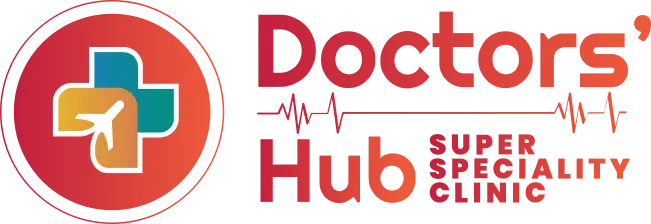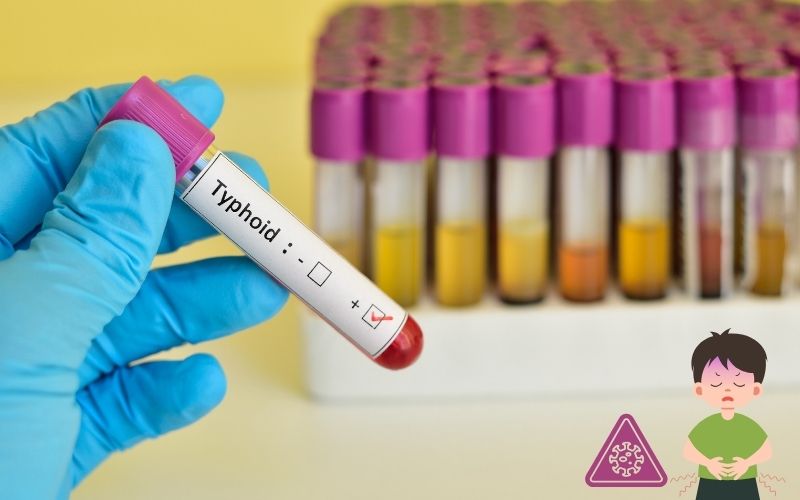Typhoid fever is a major health concern in Delhi and Gurgaon, where rain and monsoon affect health without warning. High fever, stomach pain and prolonged weakness, typhoid disrupt life for days to weeks if not treated well. People confuse it with viral fever or food poisoning, but typhoid is actually a bacterial infection.
In this detailed guide, we’ll cover everything from symptoms, causes, and testing to the best typhoid treatment in Delhi’s Dwarka and Gurgaon. Whether you’re searching for typhoid symptoms in Hindi, or just wondering “is typhoid contagious?”, this blog covers everything.
What is Typhoid? (Typhoid Meaning in Hindi)
Typhoid fever is a serious bacterial infection caused by the Salmonella Typhi bacteria. It spreads through contaminated food and water, and is most common in areas with poor sanitation or unsafe drinking water. Typhoid affects the intestinal tract and bloodstream, leading to high fever and gastrointestinal symptoms. In India, typhoid is a serious health concern during the monsoon when food and water contamination is more common due to waterlogging.
Typhoid usually develops gradually, starting with mild symptoms like fatigue or headache, and can progress to high fever, abdominal pain, and diarrhea if not treated in time.
Typhoid Meaning in Hindi:
In Hindi it is called “मियादी बुखार”.
Is Typhoid Contagious?
Yes, typhoid fever is contagious, but like common colds cough or flu. It spreads through the fecal-oral route, meaning the bacteria responsible for typhoid (Salmonella Typhi) are shed in the stool or urine of an infected person. It infects others if proper hygiene is not maintained.
How Does Typhoid Spread?
- Contaminated Food or Water: The most common route of transmission is through eating street food like chowmin, gol-gapa-water, drinking untreated tap water, or consuming unwashed fruits and vegetables that carry the bacteria.
- Poor Hand Hygiene: If someone carrying the bacteria (even if asymptomatic) handles food without washing their hands after using the toilet, the bacteria are transmitted to others.
- Household Contact: Family members or close contacts of a person with typhoid are at risk if proper hygiene is not maintained like in shared kitchens or bathrooms.
- Chronic Carriers: Some people, even after recovering, continue to carry the bacteria in their gallbladder for months or years. These chronic carriers feel completely fine but unknowingly infect others.
Is Typhoid Airborne or Spread by Coughing?
No typhoid is not airborne. You cannot catch it by simply being near someone who has it. It does not spread through coughing, sneezing, or breathing. Unlike COVID-19 or the flu, typhoid bacteria don’t travel through air droplets.
However, if someone sneezes onto food or water (with unclean hands), and that is ingested, there is still a risk.
Who is Most at Risk?
- Children under 10 years
- Elderly people with weaker immunity
- People living in areas with limited access to clean water
- Food vendors and handlers in public places
- Travelers visiting typhoid-endemic regions without vaccination
Fact about Typhoid in Delhi NCR
Cities like Delhi, especially Dwarka and Gurgaon, see spikes in typhoid cases during summer and monsoon months. Many areas experience:
- Water contamination due to sewage mixing
- Irregular piped water supply
- Overcrowded households and shared toilets
This increases the risk of wide transmission when public hygiene infrastructure is weak.
When is a Person with Typhoid Considered Contagious?
A person is most contagious during the first 1–2 weeks of illness, when the bacteria are actively multiplying in the bloodstream. However, even after the fever subsides, the person still shed the bacteria for a few weeks in their stool or urine.
In chronic carriers, bacteria shedding continue for months.
How to Prevent the Spread of Typhoid?
- Always wash hands with soap after using the toilet and before eating
- Drink only boiled or filtered water
- Avoid street food or uncovered food during the monsoon
- Get vaccinated if you live in or travel to typhoid-prone areas
- Isolate utensils, towels, and personal items of an infected person
Symptoms of Typhoid Fever (with Hindi Explanation)
Typhoid symptoms usually start gradually within 6 to 30 days after a person is exposed to the bacteria. Unlike viral fevers that come on suddenly, typhoid builds up over time.
Let’s break down the common symptoms, how they feel, what to look out for, and what they mean in Hindi.
1. Persistent High Fever
The symptom of typhoid is a rising, continuous fever that can go as high as 104°F (40°C)., fever starts low and increases day by day in a step-ladder pattern, i.e. doesn’t come and go like regular viral fevers. The body feels extremely hot, and the patient may have chills and shivering at night.
In Hindi we call it: लगातार तेज बुखार
2. Weakness and Fatigue
Typhoid drains the body’s energy. The patient feels exhausted, sleepy, and weak, even without doing anything. You struggle to get out of bed or perform daily activities. Long naps or rest still don’t help you feel fresh.
Hindi: शरीर में कमजोरी और हर वक़्त थकान
3. Abdominal Pain and Discomfort
A common complaint is a dull pain or cramping in the lower belly. Sometimes it’s on the right side, where the intestines are affected. In some cases, the stomach feels bloated, hard, or tender to touch. Kids may cry or hold their stomach a lot.
Hindi: पेट में दर्द, ऐंठन या सूजन
4. Loss of Appetite and Weight Loss
Typhoid makes food unappealing. Patients lose interest in eating, leading to sudden weight loss. Even if they eat, it cause nausea or vomiting. This can make recovery slower without proper nutrition.
In hindi it is भूख ना लगना और वजन कम होना
5. Diarrhea or Constipation
Typhoid causes diarrhea leading to frequent loose stools, especially in children and constipation, difficulty passing stool, more common in adults
Hindi: दस्त या कब्ज़ की समस्या
Note: Both symptoms can alternate during the illness.
6. Dry Cough and Sore Throat
A dry, irritating cough with mild sore throat or congestion without cold.
Hindi: सुखी खांसी और गले में खराश
7. Headache and Body Pain
Due to continuous fever and inflammation, patients experience pounding headache, in front part of the head and body aches including muscle and joint pain
Hindi: सिरदर्द और शरीर में दर्द
8. Rash (Rose Spots)
Small, pink-colored flat spots may appear on the chest or belly especially around the second week of infection. These are not itchy or painful but are a sign of bloodstream infection. It is seen in 1 out of 3 typhoid patients.
Hindi: शरीर पर गुलाबी रंग के छोटे दाने (रैश)
9. Mental Fog / Confusion in Severe Cases
In untreated or severe typhoid, especially after 2–3 weeks, patients experience confusion, drowsiness, or difficulty concentrating.
In rare cases, delirium or hallucinations (called “typhoid state”) may occur
Hindi: दिमागी भ्रम या नींद जैसी स्थिति
10. Enlarged Liver or Spleen (in advanced cases)
Doctors notice swelling in the liver or spleen on physical examination, especially if the patient has been sick for more than 2 weeks.
Hindi: लिवर या तिल्ली का बढ़ जाना
Not every patient will have all these symptoms. Some people (especially vaccinated individuals or early-treated cases) can have mild signs like just low fever or stomach upset.
4 Stages of Typhoid Fever
Doctors in Gurgaon and Typhoid specialist in Delhi divide typhoid into four clinical stages, each with symptoms and health risks.
Stage 1: Week 1 – Ear
- Gradual rise in fever (often starting around 100°F)
- Persistent headache
- General weakness and body pain
- Dry cough
- Loss of appetite and mild stomach discomfort
This is the “silent” phase. Most patients mistake these symptoms for regular viral fever or fatigue. If fever persists for 3+ days, a typhoid test should be done immediately.
Stage 2: Week 2 – Fully Developed Typhoid
- High-grade fever (103–104°F)
- Severe weakness, sleepiness
- Abdominal pain, constipation or diarrhea
- Mild rash (rose spots) on chest or stomach
- Enlarged liver and spleen (on clinical exam)
This is when bacteria multiply in the bloodstream and intestines. The patient is visibly ill, often bedridden. Dehydration and appetite loss are common.
Stage 3: Week 3 – Complication Phase
- Continuous high fever, even with medication
- Mental dullness or confusion
- Severe abdominal pain
- Internal bleeding (dark or bloody stool)
- Risk of intestinal perforation (life-threatening)
- Low platelet count, liver dysfunction
This is the most dangerous stage, especially if the patient hasn’t been treated properly. Around this time, complications like intestinal ulcers, hemorrhage, and septic shock can occur. Patients in this stage must be hospitalized immediately. IV antibiotics, fluids, and close monitoring are essential.
Stage 4: Week 4 – Recovery or Carrier Phase
- Fever starts to decline slowly
- Energy and appetite gradually return
- Digestive symptoms subside
- Some patients may continue shedding bacteria in stool (carrier state)
This is the healing phase, but recovery is slow. Even if the patient feels better, full antibiotic course and hygiene precautions must be continued.
Diagnosis and Testing for Typhoid Fever
Diagnosing typhoid is really necessary because its symptoms mimic those of other illnesses like dengue, malaria, COVID-19, or even stomach infections. That’s why paediatricians or typhoid doctors rely on lab tests to confirm it and begin the treatment quickly.
- Blood Test in Delhi or Gurgaon: A sample of your blood is taken and incubated to check if Salmonella Typhi bacteria grow. It works best during the first 7–10 days of illness, when the bacteria are present in the bloodstream.
- Widal Test: A serological test that checks for antibodies (O and H antigens) against the typhoid bacteria. It is widely used in India due to cost and speed, but not always reliable.
- Typhidot or Rapid Diagnostic Tests (RDTs): Detects IgM and IgG antibodies to Salmonella Typhi within 2–3 days of infection.
- Stool and Urine: These tests are done when blood cultures fail or in later stages of the disease.
- CBC and Platelet Count: While not specific to typhoid, a Complete Blood Count (CBC) gives helpful clues:
Typhoid Treatment in Delhi NCR & Gurgaon
The good news is typhoid is treatable, especially when diagnosed early. Most patients recover fully within 7–14 days with the right antibiotics, supportive care, and rest.
But due to rising antibiotic resistance in India, treatment now depends on the type of bacteria strain, patient condition, and response to medicines. Typhoid specialists in Delhi have following options:
- First-Line Antibiotics for Typhoid
Doctors prescribe oral or IV antibiotics depending on the severity:
| Antibiotic | Use Case | Hindi |
| Azithromycin | Mild to moderate typhoid | एज़िथ्रोमाइसिन |
| Cefixime | First choice for many Indian patients | सेफिक्साइम |
| Ciprofloxacin | Older drug, less used due to resistance | सिप्रोफ्लॉक्सासिन |
| Ceftriaxone (IV) | Severe cases or hospitalized patients | सेफ्ट्रियाक्सोन |
Warning: It is advised and recommended not to use any of the medicines on your own without proper consultation, prescription and tests. Overuse or incomplete use of antibiotics is leading to treatment failure and spreading resistant strains.
Typhoid Treatment at Home in Delhi
Along with antibiotics, the following care speeds up recovery:
- Paracetamol (for fever and headache)
- ORS and electrolyte water (to prevent dehydration)
- Light meals & khichdi (easy-to-digest food)
- Strict bed rest (to avoid weakness or collapse)
- Monitoring platelet count and hydration
Hospitalization – When It’s Needed
Hospital admission is advised if the patient has very high fever (>104°F) or doesn’t respond to oral meds In case, there is bleeding, severe abdominal pain, or signs of intestinal perforation, patient should be admitted. There are few conditions more:
- The patient is a child under 5 or an elderly person
- Co-infection is suspected (dengue, hepatitis)
In such cases, IV antibiotics and continuous monitoring are critical. Most patients start to improve within 48–72 hours once correct IV antibiotics begin.
What to Eat in Typhoid for Fast Recovery (Typhoid Diet in Hindi)
When you’re recovering from typhoid, your digestive system is weak, your body is dehydrated, and your appetite is low. That’s why a soft, nutrient-rich, and easy-to-digest diet is required
Foods to Eat During Typhoid Recovery
Here’s what Typhoid doctors in Gurgaon recommend during each stage of recovery:
1. Liquid Diet (First 2–3 days)
- Coconut water (नारियल पानी)
- Electrolyte solutions or ORS
- Clear vegetable soup (साफ़ सूप)
- Rice water (मांड)
- Herbal tea (like ginger + tulsi)
2. Soft Semi-Solid Diet (Day 3–7)
- Khichdi (rice + moong dal, soft and non-spicy)
- Mashed potatoes with minimal salt
- Steamed suji porridge or oats
- Banana (पका हुआ केला – rich in potassium)
- Steamed apple or applesauce
- Curd or buttermilk (probiotic)
3. Balanced Solid Diet (After fever subsides)
- Soft roti with boiled vegetables
- Dalia with vegetables
- Boiled eggs or soft-cooked chicken (if non-veg is allowed after 7–10 days)
- Paneer (low-fat)
- Rice with curd
Foods to Avoid During Typhoid
| Avoid These | Reason |
| Fried & oily food | Hard to digest, worsens gut inflammation |
| Spicy masalas | Can irritate stomach lining |
| Raw vegetables | Risk of bacterial contamination |
| Dairy (initially) | May cause bloating or gas |
| Caffeine, tea, coffee | Increases dehydration |
| Junk food, processed snacks | No nutrition, adds load to recovery |
Typhoid Vaccine and Prevention (Typhoid Vaccine Cost in India)
Vaccination, when combined with hygiene, can reduce the risk of typhoid by up to 80%.
When Should You Get Vaccinated?
- Before monsoon or travel to risk-prone areas
- For school-age children (mandatory in many schools)
- If you’re a food handler or healthcare worker
- Before visiting areas with poor water and hygiene access (villages, camps, construction sites)
Who Should NOT Get Vaccinated?
- People with severe allergic reactions to previous typhoid vaccines
- Children below 6 months (for TCV) or 2 years (for polysaccharide)
- Those with active fever or acute illness (wait until they recover)
Warning Signs You’re Not Recovering Properly
See your doctor immediately if you notice:
- Fever persists beyond 5–7 days of antibiotics
- Severe stomach pain or bloating suddenly increases
- Black, tarry stools (may indicate internal bleeding)
- No appetite even after 7–10 days
- Sudden weight loss or intense fatigue
Typhoid Specialists in Delhi NCR (Dwarka & Gurgaon Clinics)
At Doctors Hub, we bring together experienced physicians, diagnostic labs, and post-care support all under one roof.
Doctors Hub Super specialty clinic in Dwarka for Typhoid Treatment in Delhi
Location: Sector 12, Dwarka (Near Metro Station & Ramphal Chowk)
Specialties:
- General Medicine
- Pathology & Lab Collection
- Pediatric Typhoid Care
- Nutrition Advice for Recovery
- Typhoid vaccination (Typbar TCV, Typhim Vi)
Doctors Hub Super Specialty Clinic in Gurugram for Typhoid treatment in Gurgaon
Location: Conscient One, Sector 109, Dwarka Expressway, Gurugram
Specialties:
- Infectious Disease Consultations
- Internal Medicine & High-Risk Fever Care
- Pediatric & Adult Typhoid Treatment
- Post-typhoid fatigue & liver recovery
Typhoid treatment in Delhi NCR is affordable and can help you get healed properly within a month or two at max. So never delay your checkup if you have symptoms













